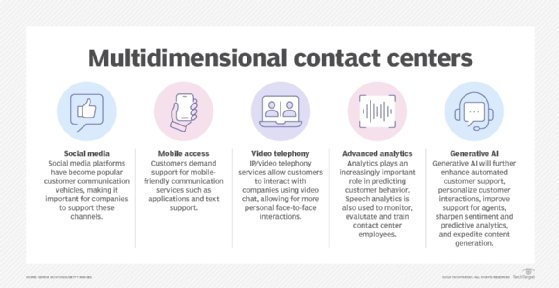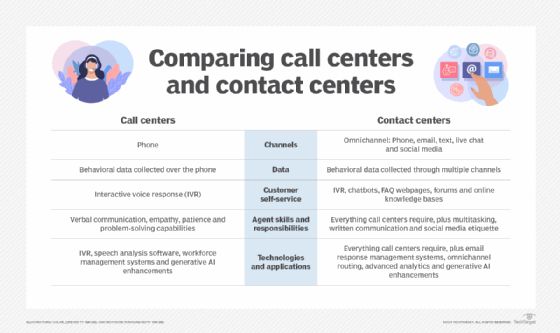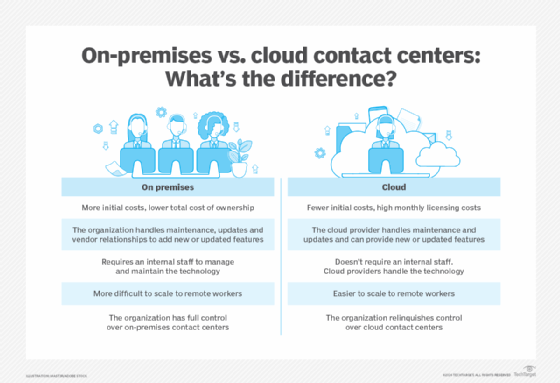What is a contact center?
A contact center is a central point from which organizations manage all customer interactions across various channels. Its primary purpose is to offer customers efficient and effective technical support, customer service and sales assistance.
Contact centers typically include one or more call centers. They might also include other types of customer contact channels, including email service, web-based live chats, documentation, knowledge base resources and social media interactions. Also, organizations often integrate contact centers with their customer relationship management (CRM) strategies.
Contact centers are growing in importance because customers expect organizations to be consistently available on various channels, not just over the phone. Contact centers are taking multichannel or omnichannel approaches, enabling them to refine customer service, increase efficiency and improve insights into customers' behaviors and needs to create better customer experiences.
Today's contact centers use a range of advanced technologies, including artificial intelligence (AI), predictive analytics, the cloud, unified communication, collaborative tools and workforce management software. These have made multidimensional contact centers a reality where customers are engaged over multiple communication channels.

The importance of having a contact center
In business today, sales aren't taken for granted, nor are they a one-time goal. Customers often expect an ongoing relationship with a business, and businesses encourage this approach, providing an engaging customer journey. Positive customer engagement can improve customer satisfaction, solve problems, drive more revenue and ultimately make the business more competitive and successful.
Contact centers are key to this approach. Consider a car dealership. A contact center might provide a variety of channels to connect a customer to the dealership, including the following:
- A website lets prospective customers view vehicle inventory and pricing, evaluate options, provide sales contact information and set up appointments for test drives.
- Email, telephone and social media channels offer initial contact options, letting prospective buyers talk to sales staff and discuss inventory.
- After a sale, contact channels such as email are used to notify owners about warranty upgrades, safety recalls and routine service intervals.
- Web resources answer questions and support automated scheduling for routine and as-needed vehicle service options.
- Social media channels let customers communicate with sales agents and post reviews and experiences.
The purpose of the contact center is to keep the customer happy and engaged throughout their experience with the product and brand. This ongoing relationship generates additional revenue and leads to more sales.
How do contact centers work?
Contact centers are similar to call centers, but they go beyond simply handling calls to reach customers on their preferred channels. Typically, contact centers include agents who handle omnichannel customer support, including calls, email, chat, voice over IP and website support.
Key elements of a full-featured contact center include the following:
- Contact distribution. Contacts are prescreened to determine the nature of the contact. They can then be assigned to the appropriate automated or human agent. Common contact management might include automatic call distributor (ACD) systems that enable contact center agents to increase the number of customer calls taken while maintaining a positive customer experience (CX).
- Analytics and reporting. Real-time reports enable contact center management to observe and analyze agent performance and customer satisfaction as it's happening across the various channels.
- Contact resources. Scripts give agents a framework to provide callers with effective support and to generate sales. Other tools and platforms give agents access to shipping, troubleshooting and other contact management capabilities.
- Shared customer data. With shared data, different agents can service a customer without needing to be briefed.
Contact center vs. call center: What are the differences?
Contact centers and call centers are both facilities designed to deliver customer service. Although the two terms are often used interchangeably, there are differences.
Call centers
The primary difference between contact and call centers is that call centers only manage phone system interactions. They handle inbound and outbound calls, generally supporting customer service, technical support and sales interactions. However, organizations can also use call centers for telemarketing, information gathering, debt and payment collection, and fraud prevention.
Contact centers
Contact centers take a multichannel or omnichannel approach to customer contacts. They typically have a modular infrastructure that enhances the team's efficiency. Contact centers serve a variety of customer service functions, and they also have advanced security measures, more secure data and increased flexibility compared with call centers.

What are the benefits of a contact center?
Contact centers provide several advantages over call centers, such as the following:
- Time and money savings. Contact centers provide customers with self-service options so they can solve their problems with two-way, keyword-driven web portals, instant messaging, text messaging or chatbot communication. Self-service is an effective customer retention strategy that decreases the amount of time agents spend on the phone, reducing customers' wait times and lowering overall costs.
- Improved safety and revenue. Contact centers can quickly identify customers based on their product purchases. They can quickly communicate product safety issues, recalls, upgrades and other notifications that can keep products safe and reliable and improve CX. Comprehensive knowledge of customer purchases and preferences also helps identify revenue opportunities such as relevant product add-ons and services.
- Better customer information. Contact centers can enhance customer profiling. When customers interact with contact centers, they share information about their personal preferences and behavior, which agents can gather and use to improve CX in future interactions. Organizations can also integrate CRM software with contact centers to collect more customer data and analyze it efficiently. Information and contact histories are typically recorded. Call recordings, provided as shared data, let agents work collaboratively to stay up to date on customer contacts and needs.
- Enhanced customer experience. Call center agents can collect data through their calls, but the digital channels that contact centers use make the process easier and more effective. Contact center software gathers customer data from every channel used and compiles it into a single customer profile. Because most contact center customers interact using multiple channels, the contact center collects more data. More data lets agents tailor CX to a caller's needs and handle call routing and other communication more efficiently.
- More effective use of interactive voice response systems. Call center solutions use IVR as an automated digital assistant that operates over the phone through vocal prompts and keypad entries. IVR in call centers often makes it difficult to reach a live agent and solve problems efficiently. However, contact centers use IVR with CX in mind. Contact center managers design IVR to predict caller intent and direct callers to the best-suited agent. Other time, IVR can solve customer queries and problems without involving live agents.
Types of contact centers and use cases
No two contact centers are exactly alike. They vary depending on the business needs and investment decisions. But most contact centers typically fall into one or more of the following classifications of contact centers:
- Inbound contact centers. Inbound contact centers focus on handling incoming customer-driven contacts. This typically results in an omnichannel contact center facility supporting several contact platforms with a high level of integration. Inbound contact centers are usually best for customer sales and support.
- Outbound contact centers. Outbound contact centers drive business-initiated contact. They're usually used to generate sales leads, drive revenue and support other communication, such as product recalls. Time is usually an important issue with these facilities, so they often focus on telephone, text and email communication platforms.
- Blended contact centers. Blended contact centers provide a mix of inbound and outbound services intended to handle all of an organization's contact needs with a well-developed and flexible workflow. This broader scope usually demands an omnichannel approach.
- Multichannel contact centers. A multichannel contact center uses several contact technologies to facilitate customer communication, including phone, email, text, SMS, mobile apps, web apps and social media commerce platform integrations. However, multichannel contact centers might not use all channels, and data collected from different channels isn't always well-integrated or shared easily among agents.
- Omnichannel contact centers. Omnichannel contact centers use the widest array of contact technologies for customer communication including phone, email, text, SMS, mobile apps, web apps, social media platform integrations and advanced technologies such as chatbots and other AI platforms. In addition, the data collected from each channel is usually well-integrated, letting all agents share data. Machine learning (ML) and AI perform extensive customer analytics.
- On-premises contact centers. Organizations can install and host these hardware contact centers on physical, on-premises servers. Organizations must have sufficient space and capacity to house and maintain the servers, appropriately trained staff, effective disaster recovery procedures and competent hardware and workflow update processes.
- Cloud-based contact centers. A contact center as a service (CCaaS) is a cloud-based contact center accessible via the internet that filters all inbound and outbound communications. Contact center agents can access cloud contact centers anywhere over the internet. These centers function the same as on-premises ones but can be more scalable. Cloud-based and virtual contact centers are often deemed identical. However, cloud contact centers operate contact services and technologies in either a public cloud or a private CCaaS cloud where agents can access the services and data from anywhere.
- Virtual contact centers. These contact centers let agents work remotely. Virtual contact centers create flexibility for contact center agents while lowering costs for the organization. These centers are similar to cloud-based ones, but virtual contact centers place the contact system hardware and technologies remotely, though not necessarily in the cloud. Agents can access the services and data from anywhere.
- Outsourced or hosted contact centers. For these contact centers, the organization outsources the infrastructure to another company that manages the systems and performs contact externally. This approach is often also referred to as CCaaS and can minimize upfront costs and maintenance, which often leads to a better return on investment.
- Offshore contact centers. These are typically facilities operated in countries other than the location of the main business. They might be fully owned and operated by the business or a third-party CCaaS provider. Offshoring is often used when an organization needs coverage and language support that's not available locally or through other outsourcing options.
- Automated contact centers. Automated contact centers embrace advanced technologies such as ML and AI to support high levels of automation and autonomy in contact center operations. These centers often use chatbots, natural language processing and speech recognition when interacting with customers to obtain information, analyze customer data and histories, and address basic customer issues.

Contact center capabilities and infrastructure
Organizations often build contact center infrastructure to support communications on the same premises as the contact center. Alternatively, organizations can outsource the infrastructure and let other companies host it externally.
In an on-premises scenario, the organization owns and manages its hardware and software. This approach requires staffing and IT investments that some organizations outsource to cloud providers or hosting companies.
Operations research and analysis and mathematical models, such as queuing theory, can support contact center performance. However, contact centers support multiple channels, so they don't have to support universal queuing. They may instead use separate systems with varying business processes.
Contact center technologies
Technologies used to maintain and improve contact center performance include the following:
- ACD system. Analyzes incoming calls and distributes them based on varying factors, such as the number called.
- Email response management system. Collects and analyzes customer inquiries submitted over email and routes those inquiries to the appropriate agent.
- Web portal. Websites are a common feature of an integrated contact center. They let customers search documentation, such as product manuals and FAQs. They also let customers perform common business functions, such as paying bills and buying new products.
- IVR system. Enables customers to use a keypad or voice commands to provide information without human assistance. For example, press one for sales; press two for service.
- Knowledge management system. This is a central repository of information that agents can easily search. It cuts down on agent training time and makes responses more effective. Such systems routinely supply detailed customer profiles and contact histories.
- TTY/TDD communications. Teletypewriters (TTY) and telecommunications display devices (TDD) offer assistance for deaf or hard-of-hearing individuals. Email and chat can help supplement TTY/TTD systems.
- Workforce management system. A workforce management system helps schedule and staff agents and monitor their performance.
Contact center systems often use call center software. For example, virtual contact centers use virtual call center software to create a channel for remote agents to manage phone calls as if they were in a centralized call center. However, contact center software often builds upon these basic abilities to further integrate services across various channels and enable agents to route contact information, track contacts and gather data.
Contact center software is available for specific business types, such as small businesses, midmarket and enterprise as well as for various price points.
The future of contact centers
As technology evolves and customers rely on newer communication channels, contact centers must continue to adapt and grow. Trends affecting contact center communications include the following:
- Social media. Social media platforms, such as Instagram or X (formerly Twitter), have become popular customer communication platforms, making it important for organizations to support these channels.
- Mobile access. Customers demand support for mobile-friendly communication services, such as application and text support.
- Videotelephony. Video telephony services, such as FaceTime and Zoom, let customers interact with organizations using video chat. This is a more personal, face-to-face type of interaction.
- Advanced analytics. Analytics is playing an increasingly important role in monitoring customer metrics and predicting customer behavior. Organizations also use speech analytics to monitor, evaluate and train contact center employees.
Industry experts expect AI and augmented reality (AR) technology to play prominent roles in contact centers of the future. AI development is currently focused on agent-assist tools that can listen in on calls and follow agent prompts to crawl customer service records and suggest answers to customers' problems during a live conversation.
AR introduces a visual element to live agent and customer interactions, so agents can suggest and show solutions to technical problems that verbal descriptions over the phone or chat can't replicate. Ultimately, ML and AI technologies are expected to perform many routine customer interactions, such as basic troubleshooting and answering simple support questions, without human intervention.
Contact centers provide businesses and other organizations with improved customer service and a competitive advantage. Find out more about the benefits of contact centers.





